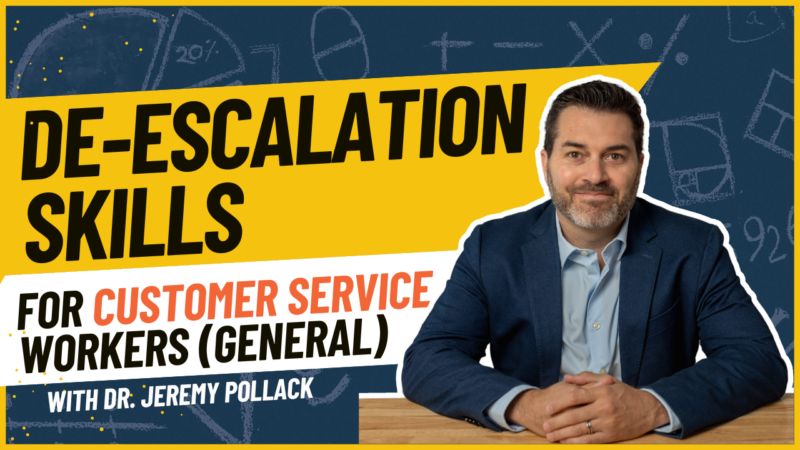In the business world, communication isn’t just about words but about everything else you do. Did you know that 55% of communication is nonverbal? This means that the majority of how a person’s message is received comes from body language, facial expressions, and other nonverbal cues rather than the words themselves.
In fact, body language can often speak louder than verbal communication. Whether you’re closing a deal, leading a team, or just interacting with a colleague, how you present yourself can shape the entire conversation.
What Is Body Language?
Body language is a powerful form of nonverbal communication that involves the physical behaviors a person uses to express thoughts, emotions, and intentions. This includes everything from hand gestures to facial expressions. Body language in the workplace can significantly impact how a message is perceived-often more than the words themselves.
Think about it: a person can say one thing verbally but convey an entirely different message through their body language cues. For example, crossing arms during a meeting might signal defensiveness, even if the verbal communication is agreeable.
In the business world, where interactions are constant and often high-stakes, being aware of your own body language and reading others’ can make all the difference. It’s not just about avoiding negative impressions-it’s about actively using body language to reinforce your message, demonstrate confidence, and build rapport.
Whether you’re leading a team, negotiating a deal, or just having a casual conversation with a colleague, your body language is always at work, communicating volumes even when you’re silent.

Understanding Body Language in the Workplace
Understanding body language in the workplace is essential for effective communication. The way you interpret and respond to nonverbal communication can influence your relationships with colleagues, your leadership style, and even your career trajectory.
This section will explore the common types of body language and how they impact workplace dynamics, helping you to navigate the professional environment better.
Common Types of Body Language
Positive body language includes behaviors that convey openness, confidence, and approachability. For example, maintaining good posture, using appropriate hand gestures, and maintaining eye contact can make you appear engaged and trustworthy. Facial expressions like smiling or nodding during a conversation signal that you’re attentive and supportive, which can foster stronger connections with your colleagues.
Conversely, negative body language can create barriers to communication. Crossed arms, for instance, might indicate defensiveness or unwillingness to engage, even if that’s not the case. Additionally, fidgeting or frequently shifting body movements can signal nervousness or a lack of confidence, potentially undermining your authority or credibility in a discussion.
How to Read Body Language Signals
To effectively read body language in the workplace, you need to pay attention to several key nonverbal communication signals.
- Facial expressions are among the most telling indicators of a person’s feelings. For instance, a smile often signals agreement or happiness, while a furrowed brow might indicate that someone is confused or concerned. By closely observing these cues, you can gain insights into what others might be thinking, even if they’re not expressing it verbally.
- Eye contact is another crucial element. A person who maintains steady eye contact is often perceived as confident and honest, while someone who avoids it may be seen as mysterious or untrustworthy. However, it’s important to balance eye contact, as too much can be perceived as aggressive, while too little might come off as disinterest.
- Hand gestures also play a significant role in communication. Open, relaxed gestures typically indicate a willingness to engage, while clenched fists or pointing fingers might convey aggression or frustration.
- Personal space must be considered at all times. Respecting personal space is crucial in maintaining professionalism. Standing too close to someone might make them uncomfortable, while standing too far away could signal disinterest. Finding the right balance helps create a comfortable environment for both you and your colleagues.
The Correlation Between Body Language and Workplace Dynamics
The way body language influences workplace dynamics cannot be overstated. In a team setting, positive body language can foster collaboration and mutual respect. For instance, open body movements, attentive facial expressions, and appropriate hand gestures contribute to a harmonious work environment where ideas are freely shared and all members feel valued.
Conversely, negative body language can lead to misunderstandings, conflicts, and a toxic work environment. When a person consistently exhibits negative signals-like avoiding eye contact, invading personal space, or using aggressive hand gestures-it can create tension among team members, disrupt communication, and lower overall morale.

Body Language and De-escalation
In any tense situation, one’s own body language can be the key to defusing conflict before it escalates. Understanding how to use body language effectively allows you to communicate calmness, empathy, and control without saying a word.
Body language plays a crucial role in de-escalation, as described below.
The Role of Body Language in De-escalation
Body language is a powerful tool in de-escalation because it speaks directly to the emotional brain. When emotions run high, logical reasoning often takes a back seat, and people respond more to nonverbal signals than to words. Making subtle adjustments, such as making eye contact, maintaining good posture, and using open facial expressions, can signal to the other person that you are listening, empathetic, and not a threat.
For those in business administration, where managing people and conflicts is routine, mastering de-escalation through body language can enhance your leadership effectiveness.
Examples of De-escalating Tense Situations Through Body Language
Conflict in a Meeting
Imagine you’re in a heated meeting where voices are raised and tensions are running high. Two colleagues are glaring at each other, clearly on the brink of a verbal clash. Instead of letting the situation escalate, you can step in with calming nonverbal cues.
Start by making brief but steady eye contact with each of them, signaling that you’re engaged and aware of the tension. Use a calm facial expression and a slow nod to acknowledge their concerns without saying a word. Maintain a good posture by sitting tall, which conveys confidence and control.
Finally, if appropriate, offer a handshake as a nonverbal gesture of peace, signaling that it’s time for everyone to cool down and focus on finding a solution.
Customer Complaint
If a customer becomes upset and starts raising their voice, it’s important not to respond defensively. Instead of making direct eye contact that could be perceived as aggressive, offer a gentle smile while maintaining a neutral facial expression. This helps to diffuse the tension.
Lean in slightly to show your engagement, and use open hand gestures to indicate that you’re ready to listen and resolve the issue. This calm, nonverbal approach can effectively de-escalate the situation and prevent it from escalating further.
Workplace Argument
In a heated disagreement between team members, one’s own body language can be crucial in diffusing tension. If someone adopts an aggressive stance and uses sharp hand gestures, you can help de-escalate the situation by consciously keeping your hands relaxed and visible.
At the same time, maintaining eye contact shows that you’re focused on finding a solution rather than escalating the conflict. This calm and composed contrast in body language can effectively reduce aggression in the workplace, helping to steer the conversation toward resolution.
Tense Video Call
In a remote meeting, misunderstandings can quickly escalate if emotions aren’t managed well. If you notice someone becoming visibly agitated, focus on keeping your posture open and relaxed to avoid adding to the tension. Use empathetic facial expressions and nod occasionally to show that you’re actively listening and understanding their concerns.
Even though you’re not physically in the same room, these nonverbal cues can still create a sense of connection and help de-escalate the situation before it spirals out of control.
Common Mistakes to Avoid
- Crossing your arms: This can make you appear defensive or closed off, which might escalate the situation further.
- Standing too close: Invading personal space can be intimidating and may increase tension.
- Ignoring cultural norms: Different cultures interpret body language differently, so it’s important to be mindful of these differences to avoid unintentional offense.
- Overpowering eye contact: While making eye contact is important, too much can seem aggressive rather than calming.
Benefits of Body Language Training
Body language training can transform how you interact in the workplace, helping you connect better with colleagues, resolve conflicts more easily, and boost overall productivity.
Improved Workplace Communication
Effective communication goes beyond words. Nonverbal cues like eye contact, body posture, and hand movements play a crucial role in how your message is received.
Think about a time when you had a conversation with someone who couldn’t maintain eye contact. It probably left you questioning their sincerity or interest in the discussion. By maintaining eye contact, you signal that you’re engaged and trustworthy, which can lead to more meaningful and effective interactions.
Body language training teaches you to communicate effectively by ensuring that your eye gaze and body posture align with the words you’re saying so you consistently send the right message.
Enhanced Conflict Resolution
When tensions rise, how you handle yourself can make all the difference. Body language training helps you develop high levels of emotional intelligence, equipping you to manage conflicts calmly and professionally.
Picture a heated discussion where both parties are on the brink of losing their cool. Remaining calm and using controlled hand movements to express openness can de-escalate the situation.
In contrast, defensive postures or aggressive gestures can fuel the fire. Understanding micro expressions-the brief, involuntary facial expressions that reveal true emotions-also allows you to gauge the other person’s feelings more accurately, enabling you to address issues before they escalate further.
Positive Impact on Team Dynamics and Productivity
A team that communicates well thrives. Body language training improves individual interactions and enhances the overall dynamics within a team. When team members are aware of their nonverbal cues and how these affect others, collaboration becomes smoother, and misunderstandings are minimized.
For instance, a leader who can exude confidence through positive body posture and eye contact will naturally instill trust and motivation in their team. This sets the tone for a productive work environment where everyone feels heard and valued.
Moreover, when everyone on the team has a better idea of how to effectively communicate nonverbally, the group is more likely to work together seamlessly, leading to higher productivity. A simple smile or nod during a meeting can go a long way in making someone feel appreciated and boosting morale, ultimately creating a more cohesive and successful team.

Defuse De-escalation Training’s Approach
At Defuse, we understand that every workplace is unique, and so are the challenges that come with it. That’s why our approach to de-escalation training courses is tailored to meet the specific needs of different industries.
Training Modules Offered
Our training modules are designed to cover a wide range of scenarios, ensuring that your team is prepared for anything. We offer comprehensive courses that delve into nonverbal cues, emotional self-regulation, and the psychology behind conflict and aggression.
Whether your team needs to learn how to actively listen during a heated discussion or manage video calls where tensions might run high, our modules provide the practical knowledge necessary to de-escalate situations effectively.
One of our key offerings includes workshops that focus on understanding and utilizing nonverbal cues to communicate effectively. These cues often speak louder than words, and mastering them can be the difference between resolving a conflict and escalating it.
Our de-escalation training courses also emphasize the importance of recognizing early red-flag behaviors that could signal an impending conflict, allowing your team to take preventive action.
Skills and Techniques Taught
In our training, we focus on building practical skills that your team can use in real-world situations. We guide participants through techniques like controlled breathing and actively listening to communicate empathy and understanding, which are critical in diffusing tension. We also cover the importance of maintaining open body language and building rapport with others, as these are fundamental to de-escalating any situation.
Our trainers use role-playing and scenario-based exercises to ensure that these skills are ingrained in your team’s daily interactions. By the end of our training, participants will be able to communicate their key points clearly and calmly-even under pressure. This not only helps defuse potential conflicts but also ensures that everyone involved feels heard and respected.
Customized Programs for Different Industries
We know that the same way of handling conflict won’t work for every industry. That’s why we customize our programs to address the specific challenges faced by your team. Whether you’re in healthcare, customer service, law enforcement, education, or any other field, our training is designed to meet your unique needs.
For instance, a healthcare team might need to focus more on calming anxious patients, while a customer service team might need to handle frustrated customers over the phone or in video calls.
Take Control of Your Communication Skills
Understanding and mastering body language can be a game-changer in your professional life. Whether you’re trying to communicate more effectively, resolve conflicts, or improve team dynamics, the way you present yourself nonverbally is just as important as the words you say. Becoming a body language expert not only enhances your interactions but also empowers you to lead and influence others positively.At Defuse De-escalation Training, we’re committed to helping you and your team master these essential skills. Contact us today to learn how our customized de-escalation training can transform your workplace dynamics.







